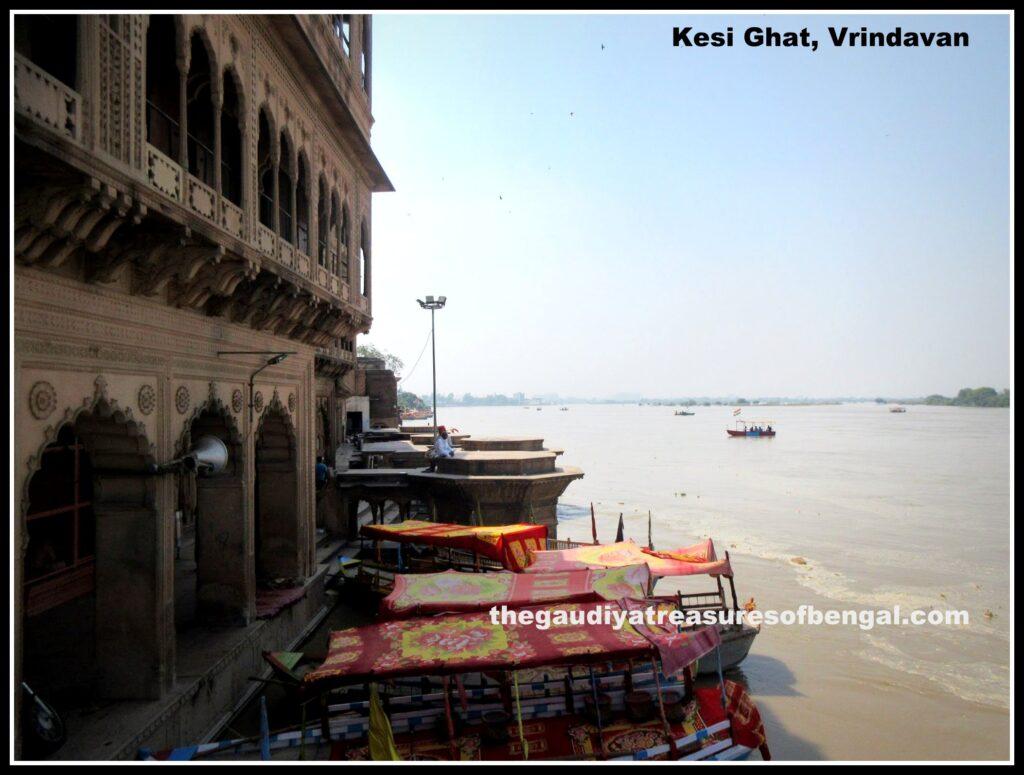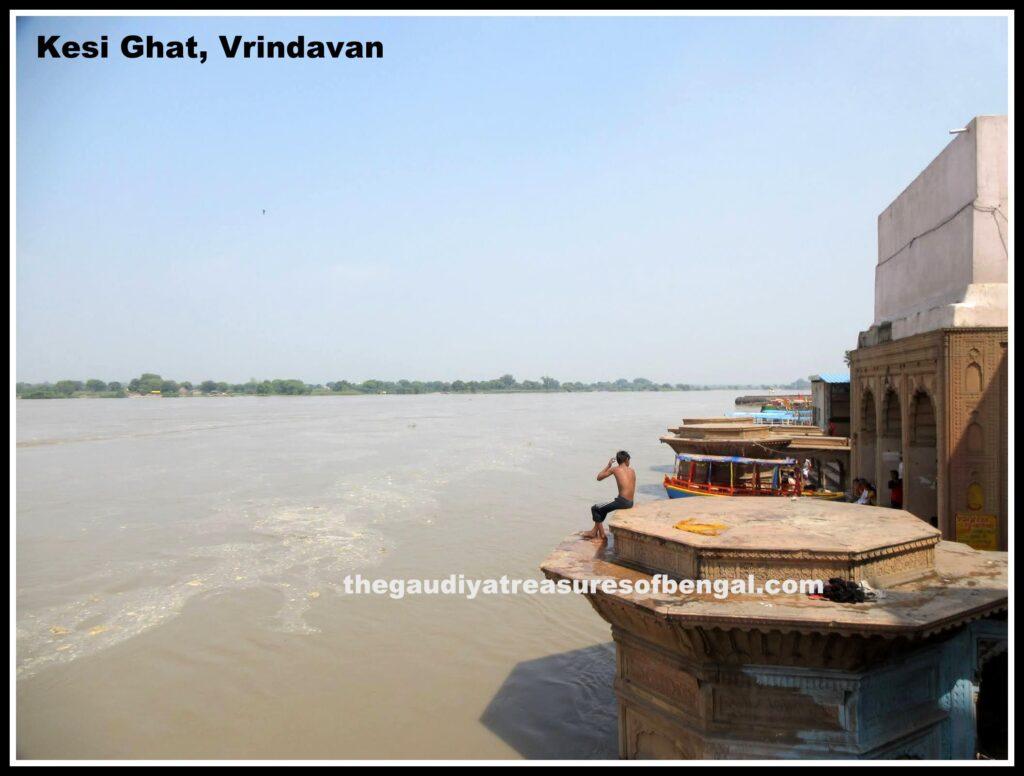
Situated slightly to the east of Chir-ghat on the tranquil banks of the Yamuna River, Kesi Ghat reigns as the prominent bathing spot in the enchanting town of Vrindavan. Adorned with opulent palaces adorned with intricate stone inlays and boasting a magnificent view of the grand Madanmohan temple in the background, Keshi Ghat stands as one of the most resplendent ghats along the Yamuna. The sacred river Yamuna flows gracefully here, extending her divine essence to all beings without discrimination. Merely by touching, drinking, seeing, smelling, or immersing oneself in her pristine waters, one experiences boundless purification.
The name of this ghat (a series of descending steps leading to the water’s edge) is derived from a remarkable incident in Lord Krishna’s pastimes – the slaying of the demon Keshi. Following His victorious encounter with Keshi, Krishna made His way to the ghat along the Yamuna’s banks to cleanse Himself. His hand had become ensnared in the vile mouth of the demon, necessitating a thorough purification. Henceforth, this hallowed site acquired the appellation of Keshi Ghat, forever commemorating the divine encounter.
Krishna Kills Kesi Demon
Upon receiving instructions from Kamsa (Krishna’s evil maternal uncle), the malevolent demon Kesi assumed a fearsome manifestation in the form of a monstrous horse. With a tremendous presence, he ventured into the serene expanse of Vrndavana, his majestic mane billowing in the wind and his powerful hooves relentlessly pounding the earth’s surface. Unleashing piercing whinnies that reverberated through the surroundings, the demon instilled terror into the hearts of all who dwelled in that realm. Observing the immense distress inflicted upon the inhabitants of Vrndavana by the demon’s eerie cries and his tail swirling high above like a colossal cloud, Lord Krishna perceived that the horse had issued a direct challenge to engage in combat.

Accepting the audacious defiance, the Lord positioned Himself before the formidable Kesi demon, summoning him to engage in battle. Responding to the call, the horse advanced menacingly towards Krishna, emitting a horrifying sound reminiscent of a mighty lion’s roar. Kesi charged with tremendous swiftness, aiming to trample the Lord with his immensely sturdy and unyielding legs, akin to solid stone. Yet, Krishna swiftly seized hold of the demon’s legs, effectively foiling his aggressive maneuver. Fuelled by a hint of fury, Krishna deftly maneuvered around the horse, skillfully evading his onslaught. After circling the demon a few times, the Lord hurled him a considerable distance of a hundred yards, reminiscent of how Garuda flings a massive serpent.
Upon being hurled by the divine force of Krishna, the horse immediately lost consciousness. However, after a brief interval, he regained his faculties, fiercely reinvigorated and surged towards Krishna once again, this time with his mouth agape. In an instant, as Kesi reached the Lord, Krishna promptly thrust His left hand into the horse’s gaping maw. The horse experienced excruciating agony, perceiving Krishna’s arm as searing hot iron. Subsequently, the demon’s teeth were dislodged, unable to withstand the searing pain inflicted by the Lord’s touch. Inside the horse’s mouth, Krishna’s hand began to expand, constricting Kesi’s throat. As the mighty steed began to suffocate, beads of perspiration surfaced on his body, and in a frenzy, he thrashed his legs in every direction. With each passing moment, the horse’s life force waned, and as his final breath escaped, his eyes bulged out of their sockets, and he involuntarily released both excrement and urine.
As the life force dwindled within the horse, his mouth slackened, allowing Krishna to extricate His hand with ease. The Lord remained unaffected by the apparent ease with which He vanquished the Kesi demon, yet the demigods were astounded by the spectacle, and in profound admiration, they hailed Krishna by showering colorful flowers upon Him.
Kesi Demon and the peril of Self Superiority : Eighteenth Obstacle
The eighteenth impediment (anartha) takes the form of the formidable demon Kesi, who manifests as a mighty horse. As the neophyte devotee rapidly progresses on the path of devotion, a subtle danger emerges—the sense of personal superiority. Should the novice allow unchecked speculation to arise regarding their own eminence, it possesses the potential to lead them down the treacherous path of disrespecting the Divine, ultimately resulting in their downfall. Thus, it becomes imperative that such malevolent sentiments never take root within the heart of the Vaishnava practitioner.Even as devotion flourishes and reaches its pinnacle, the essence of genuine humility must forever permeate the conduct of the Vaishnava. The absence of this sacred quality poses a grave risk, demanding the intervention of Lord Krishna in slaying the demon Kesi. The Vaishnava path, therefore, mandates an unwavering commitment to remain free from the allure of self-importance, recognizing it as a pernicious force that must be vanquished.
The divine episode of Lord Krishna’s triumphant slaying of the formidable Kesi demon, who had cunningly assumed the imposing guise of a colossal horse, hence carries a profound symbolic significance. It serves as a powerful metaphor, illustrating the liberation of the sincere devotee from the enthrallment of falsely perceiving oneself as an elevated and accomplished worshiper. In this captivating tale, the Kesi demon embodies the deceptive allure of spiritual pride and egotism that can pervade the hearts of even those engaged in devotional practices. By manifesting as an imposing horse, Kesi represents the inflated self-image and the illusory sense of personal greatness that can cloud one’s genuine dedication to the Supreme. Krishna’s valiant act of subduing and ultimately slaying the Kesi demon signifies the divine intervention necessary to shatter the illusions and false notions that veil the sincere devotee’s consciousness. It serves as a potent reminder that true devotion cannot flourish amidst the treacherous realms of self-aggrandizement and self-delusion. Thus, the captivating narrative of Krishna’s victory over the deceptive Kesi demon imparts a profound spiritual lesson, guiding the earnest practitioner towards humility, authenticity, and the realization that genuine devotion thrives in the soil of selflessness, unadulterated surrender, and the humble recognition of one’s true place in the cosmic tapestry of divine love.
How to Reach
Situated adjacent to Chir Ghat and Nidhivan, Keshi Ghat graces the banks of the revered Yamuna River in the sacred town of Vrindavan.
Reaching Vrindavan :
- By Air: The nearest airport to Vrindavan is the Indira Gandhi International Airport in New Delhi, which is about 150 kilometers away. From there, you can hire a taxi or take a bus to Vrindavan.
- By Train: Vrindavan has its own railway station, which is well connected to major cities in India. You can take a train from Delhi, Agra, Jaipur, or Mathura to reach Vrindavan.
- By Road: Vrindavan is well connected by road to major cities in the region. You can take a bus or hire a taxi from Delhi, Agra, or Mathura to reach Vrindavan.